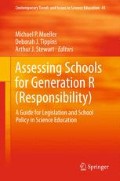Abstract
As society changes, so has its connection with the natural world, especially for children. This chapter briefly looks at how beneficial nature can be for children, even though their interaction with it has changed drastically in the past few decades. As organizations and researchers have become aware of this, they have searched to find ways to better existing natural science programs and develop new ones, which help children strengthen their identities and connections to the natural world. This chapter looks at one such program, an after-school nature club for fourth graders. This study revealed several beneficial findings in environmental identity development, which would be helpful for program development and policy design. Among the findings, the semiformal nature club helped students develop traits that couldn’t be measured on current standardized tests. By combining an understanding of cognitive development in children with key themes that emerged through nature club, the chapter concludes with a discussion on how to strengthen future programs and poses questions about current standardized tests, all of which would be helpful for policymakers.
Access this chapter
Tax calculation will be finalised at checkout
Purchases are for personal use only
References
Appleton, K. (2008). Developing science pedagogical content knowledge through mentoring elementary teachers. Journal of Science Teacher Education, 19(6), 523–545.
Brock, R. (2010). Exploring the development of fourth graders’ environmental identity through participation in a semi-formal nature club. Unpublished dissertation, University of Nevada, Reno.
Brock, R., & Crowther, D. (2011, January). Linking Piaget’s cognitive development theory to environmental identity development through use of an After-School Nature club. Paper presented at the Association of Science Teacher Education (ASTE) International Conference on Science Education. Minneapolis. Proceedings available online: http://theaste.org/meetings/2011conference/2011proceedings.pl
Clayton, S. (2003). Environmental identity: A conceptual and an operational definition. In S. Clayton & S. Opotow (Eds.), Identity and the natural environment: The psychological significance of nature (pp. 45–65). Cambridge: MIT Press.
Coyle, K. (2005). Environmental literacy in America: What ten years of NEETF/Roper research and related studies say about environmental literacy in the US. Washington, DC: The National Environmental Education and Training Foundation.
Kahn, P. H., Jr. (1999). The human relationship with nature: Development and culture. Cambridge: The MIT Press.
Kahn, P. H., Jr. (2002). Children’ affiliations with nature: Structure, development, and the problem of environmental generational amnesia. In P. Kahn & S. Kellert (Eds.), Children and nature: Psychological, sociocultural, and evolutionary investigations (pp. 93–116). Cambridge: MIT Press.
Kellert, S. R. (2002). Experiencing nature: Affective, cognitive, and evaluative development in children. In P. Kahn & S. Kellert (Eds.), Children and nature: Psychological, sociocultural, and evolutionary investigations (pp. 117–151). Cambridge: MIT Press.
Kriesberg, D. A. (1999). A sense of place: Teaching children about the environment with picture books. Englewood: Teacher Ideas Press.
Louv, R. (2006). Last child in the woods: Saving our children from nature-deficit disorder. Chapel Hill: Algonquin Books of Chapel Hill.
Marx, R. W., & Harris, C. J. (2006). No child left behind and science education: Opportunities, challenges, and risks. The Elementary School Journal, 106(5), 467–477.
Mayer, F. S., & Frantz, C. M. (2004). The connectedness to nature scale: A measure of individuals’ feeling in community with nature. Journal of Environmental Psychology, 24(4), 503–515.
Nisbet, E. K., Zelenski, J. M., & Murphy, S. A. (2009). The nature relatedness scale: Linking individuals’ connection with nature to environmental concern and behavior. Environmental and Behavior, 41(5), 715–740.
Opotow, S., & Brook, A. (2003). Identity and exclusion in rangeland conflict. In S. Clayton & S. Opotow (Eds.), Identity and the natural environment (pp. 249–272). Cambridge: MIT Press.
Roser, R. W., Eccles, J. S., & Sameroff, A. J. (2000). School is a context of early adolescents’ academic and social-emotional development: A summary of research findings. The Elementary School Journal, 100(3), 443–470.
Schultz, P. W., Shriver, C., Tabanico, J. J., & Khazian, A. M. (2004). Implicit connections with nature. Journal of Environmental Psychology, 24(1), 31–42.
Singer, D. G., & Revenson, T. A. (1997). A Piaget primer: How a child thinks. Madison: International Universities.
Splitter, L. (2000). Philosophy for children. In M. Robertson & R. Gerber (Eds.), The child’s world: Triggers for learning. Camberwell: ACER Press.
Taylor, A. F., & Kuo, F. E. (2006). Is contact with nature important for healthy child development? State of the evidence. In C. Spencer & M. Blades (Eds.), Children and their environments (pp. 124–140). New York: Cambridge University Press.
Thomashow, M. (1995). Ecological identity: Becoming a reflective environmentalist. Cambridge: MIT Press.
Author information
Authors and Affiliations
Corresponding author
Editor information
Editors and Affiliations
Rights and permissions
Copyright information
© 2014 Springer Science+Business Media Dordrecht
About this chapter
Cite this chapter
Brock, R.J., Crowther, D.T. (2014). Benefits of Elementary Environmental Education. In: Mueller, M., Tippins, D., Stewart, A. (eds) Assessing Schools for Generation R (Responsibility). Contemporary Trends and Issues in Science Education, vol 41. Springer, Dordrecht. https://doi.org/10.1007/978-94-007-2748-9_11
Download citation
DOI: https://doi.org/10.1007/978-94-007-2748-9_11
Published:
Publisher Name: Springer, Dordrecht
Print ISBN: 978-94-007-2747-2
Online ISBN: 978-94-007-2748-9
eBook Packages: Humanities, Social Sciences and LawEducation (R0)

